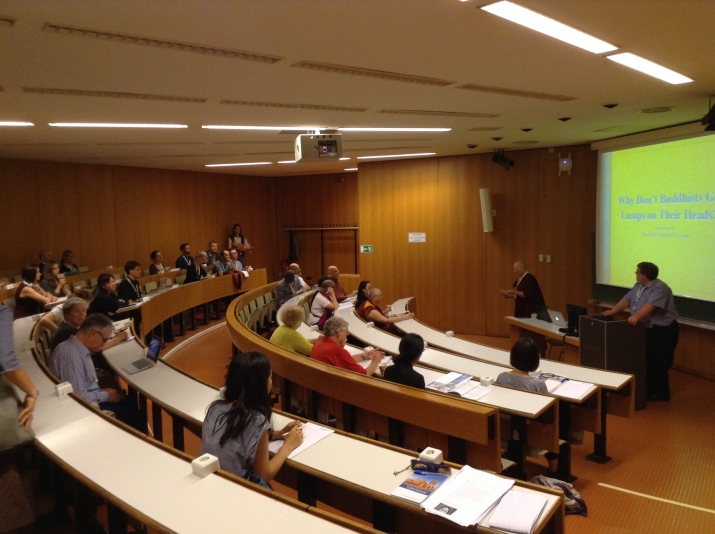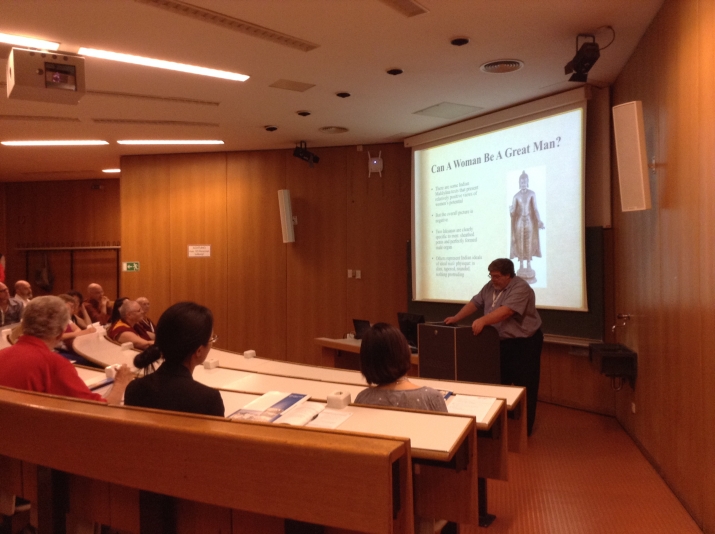FEATURES|THEMES|Women
Rethinking Buddhist Practices and the Buddha’s Bodily Features—An Interview with John Powers
Buddhistdoor Global | 2014-10-17 |
 Karma Lekshe Tsomo chairing the “Gender in Buddhism” section. From Elsa Lau
Karma Lekshe Tsomo chairing the “Gender in Buddhism” section. From Elsa LauHave you ever considered that your Buddhist practice could actually result in the development of physical abnormalities like those of the Buddha: a fist-sized cranial protuberance, webbed fingers and toes, an enormous tongue, a lion-like jaw and torso, and a sheathed penis?
According to the Pali suttas and Mahayana sutras and shastras, these are some of the 32 major physical characteristics (Skt lakshana) of a “great man” (Skt mahapurusha), meaning someone with spiritual attainments according to Buddhism. However, what are the implications of these “odd” features from the Indian texts for contemporary Buddhists today? Are female bodies inferior to male ones? On 19 August, in the section “Gender in Buddhism” at the 2014 IABS, Professor C. John Powers of the Australian National University examined precisely these questions in his fascinating paper “Why Don’t Buddhists Get Lumps on Their Heads? Implications of Indian Notions of Masculinity for Contemporary Buddhists.”
Physical Features in Indian Buddhist Literature
Having established his reputation as a scholar of Tibetan Buddhism in the past few decades, John told me that his previous research had mainly been on philosophical literature, and particularly Yogacara. A Bull of a Man (Powers 2009) was his first book-length study in the field of cultural history. In his book, John stated that masculinity in Buddhism and the Buddha’s physical abnormalities have been overlooked by most Buddhists. So what prompted him to begin this research? And what is its significance?
“I was co-teaching a course entitled ‘History and Theory’ with my colleague and friend Chris Forth, who specializes in European masculinities,” explained John. “I read one of his books that focused on the Dreyfus trial in France, and as I did, I kept thinking of images of masculinity I'd seen but not really noticed in Indian Buddhist texts. I started re-reading Indian Buddhist literature, and was struck by the fact that these images, particularly images of the Buddha's body and its importance to his teaching and conversion, are pervasive. The trial and conviction of Dreyfus, a French Jewish military officer, is generally portrayed in terms of anti-Semitism, but Forth demonstrated how changing images of masculinity were significant factors. Because most people in a given society unconsciously accept such ideas without question, they are seldom seen as notable or problematic, but when I began reading the Indian Buddhist texts in which they appear, it was obvious that Indians at the time of the Buddha and in following centuries had profoundly different views of their bodies than contemporary Buddhists, particularly in the West.”
Although topics relating to the body and masculinity are centrally important in Indian Buddhist literature such as the Pali canon and Vasubandhu’s Abhidharma-kosha, a highly influential work of Buddhist scholasticism, John found it remarkable that they have largely been ignored by both scholars and Buddhist practitioners who rely on Indian texts as their canon. Neither of these tropes has been discussed in the most popular English-language Buddhist magazines, or in the dozens of books written for Western Buddhists.
Attaining Buddhahood and Obtaining the Physical Abnormalities
In fact, meditators are often reminded to practice “letting go,” or detaching from their bodies, through practices such as asubha.* I wondered whether such spiritual practices affect our physical appearance. As John explained, there are numerous practices that purportedly lead to physical changes, such as phowa (transference of consciousness), which can cause a hole to develop in the crown of the head, and sometimes a flow of blood and lymph. Shamatha practice (single-pointed concentration on an object) can also lead to physical changes. Geshe Gedün Lodrö’s book Walking Through Walls (Lodrö 1992) begins with a discussion of possible effects, including physical lightness, which can lead to the ability to pass through solid objects. Eventually, according to hundreds (or perhaps thousands) of Indian Buddhist texts, successful meditative practice will cause one to develop the 32 major characteristics of a great man. John added that although many Buddhist teachers strive to guide their students towards Buddhahood, he has never heard that they remind them not to be concerned if they develop a large lump on their head or elongated arms as a result of an extended meditative retreat or engagement in meritorious activities.
John stressed that anyone following a Buddhist path who might be worried about this issue should remember that “many of the people he [the Buddha] converted weren't convinced by his words, but by his body.” In fact, for someone trying to develop the body, speech, and mind of a Buddha and envisaging performing enlightened activities, this should, according to Indian texts, be a central concern.
 John Powers presenting his lecture. From Elsa Lau
John Powers presenting his lecture. From Elsa LauGood Looks Result from Practice
Would it be a contradiction for meditators to aim towards obtaining either physical beauty or the abnormalities along their spiritual path? The development of a beautiful body is the inevitable outcome of successful practice, says John: it proves one has been doing things right. He then told me an intriguing story that was reportedly shared by the current Karmapa with one of John’s PhD students. As the story goes, the first Karmapa was as ugly as a monkey, as a result of which his wife left him. When he became a Buddhist, he took a vow that his practice would lead to his successors having beautiful bodies, and ever since, the Karmapas have all been handsome. John said that this also applies to those who are wealthy or otherwise well favored by birth: it is a result of their past practice. If a person looks good, he has been good. “Hence, the Buddha was the most handsome man of his time, and endowed with supreme physical perfection as a result of his meditation and cultivation of merit.”
Can a Woman be a “Great Man”?
If the Buddha’s physical abnormalities are the result of spiritual attainments, how should contemporary female Buddhists feel about these original texts? John gave me a disappointing answer: “Until the tantras—and even there it's very problematic—there's no sense in Indian Buddhism that women can attain any of the advanced stages of the path, and certainly not Buddhahood.” He went on to explain that, if the texts are correct, females will have to develop disgust for their form and engage in practices designed to prevent them from being reborn in a female body. And if females want to visualize themselves as a Buddha, this involves visualizing an Indian ideal of a male body, including a perfect male organ.
What about Chinese Buddhist texts? It seems that the situation for Chinese women is no more optimistic. John mentioned the Chinese Buddhist sutra, the Blood Bowl Sutra (Ch. ???ָg; Xuepen jing), which condemns women to hell for the sin of menstruation. Both Indian and Chinese Buddhist texts take it as a given that women's bodies are inferior to those of men. John reminded me that contemporary women who reject such ideas have a lot of work to do in reinterpreting the Buddhist tradition in a way that accords with their world view.
The Buddha Image as a Cultural Construct
At the end of the concluding chapter of John’s book, he appears to suggest that the Buddha’s image is culturally constructed. Then how serious should we be about the 32 major characteristics of a “great man” in the ancient texts?
“That's the big question. The image of the Buddha's body is a cultural construct, but his perfect body was the decisive factor in many of his activities,” he replied, and said that there was no similar idea of a perfect body in the West or Asia today that can do the things the Buddha's body did for him. If someone develops the kind of body that contemporary societies regard as beautiful, people do not perceive them as wise or enlightened. However, the Buddha's body was a unique testament to his attainments, and provided irrefutable proof of his Buddhahood.
A Bull of a Man is a well-researched, thought-provoking book that encourages contemporary Buddhists to re-read the Indian texts and consider the implications for their own practice.
*Asubha meditation is a practice on foulness such as contemplation on dead bodies.
References
Lodrö, Geshe Gedün. 1992. Walking Through Walls: A Presentation of Tibetan Meditation. Edited and translated by Jeffrey Hopkins. Ithaca: Snow Lion Publications.
Powers, John. 2009. A Bull of a Man: Images of Masculinity, Sex, and the Body in Indian Buddhism. Cambridge, MA; London: Harvard University Press.
Acknowledgements
I would like to express my gratitude to Professor John Powers for sharing his time and knowledge.

Categories:
Comments:
Share your thoughts:













